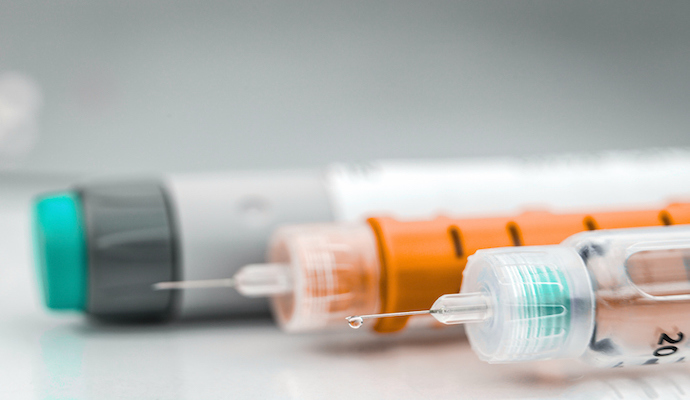Illinois Caps Out-of-Pocket Costs for Insulin at $100 for Insured
Illinois signed a Senate bill into law on January 24 that caped out-of-pocket costs for insulin at $100 for a 30-day supply, marking a new trend for states.

Source: Getty Images
- Following in Colorado’s footsteps, Illinois became the second state to cap out-of-pocket costs for insulin at $100 for a 30-day supply after Gov. JB Pritzker signed SB 667 into law on January 24.
An amendment to Senate Bill 667, sponsored by Sen. Andy Manar (D-Bunker Hill), introduced the cap affecting about 1.3 million adults in Illinois with type 1 diabetes, type 2 diabetes, and gestational diabetes mellitus. The General Assembly approved the bill last November, signaling that the “state will no longer allow pharmaceutical companies to take advantage of Illinoisans living with diabetes by charging exorbitant prices for lifesaving insulin medication,” Manar said.
According to the new law, insurers must limit the total amount that the insured is required to pay for a 30-day supply of covered prescription insulin drugs to no more than $100 under the new law. This is “regardless of the quantity or type of covered prescription insulin drug used to fill the insured's prescription.”
But the law has the potential to further reduce costs for those living with diabetes.
The 21-page document clarifies that nothing “prevents an insurer from reducing an insured's cost-sharing by an amount greater than the amount specified in subsection (c) [$100].” The cap is to be adjusted January 1 of each year consistent with the Consumer Price Index fluctuation.
READ MORE: USMCA Approval Signals Drug Pricing Changes Ahead
“Health care is a right for all, not a privilege and that is why I am so proud that we created an insulin price cap that successfully puts patients above profit," said Pritzker about the new law.
Other provisions underscore the need for additional information to inform future policy on insulin pricing. The Department of Insurance, the Department of Human Services and the Department of Healthcare and Family Services are to produce and make public findings in a report due by November 1, 2020. The report is to include a summary of insulin pricing practices and health plan pricing variables. The law also calls on the departments for the report to provide a set of “public policy recommendations to control and prevent overpricing of prescription insulin drugs made available to Illinois consumers” and additional information if deemed necessary.
Most of the provisions take effect on January 1, 2021.
Senior vice president of government affairs & advocacy for the American Diabetes Association, LaShawn McIver, said that the ADA supported the legislation as it “marks a major victory in our fight for affordable insulin for all who need it."
But other stakeholders have expressed concerns. The bill that established the cap in Colorado in May 2019 reportedly has a “loophole” thanks to lobbying on the part of insurers whereby patients are paying more out-of-pocket costs than had been intended. This is because the $100 cap only applies to a single prescription. Rep. Dylan Roberts said, “It’s the difference of many hundreds of dollars over the course of the year.”
READ MORE: Drug Price Hikes Undeterred Despite Legislative Proposals
There were also concerns with the potential for the cap to lead to increased health insurance rates under the new law in Colorado but a Colorado Sun investigation found that it has not led to such hikes.
With Congress at an impasse with soaring drug prices over the past few years, Pritzker’s move marks the beginning of a new nationwide trend as many other states consider similar measures.
“As we work to address the high cost of prescription drug prices that are burdening millions all across our state, this new law is an essential step in fulfilling our promise to put state government back on the side of working families,” Pritzker noted. The initial focus coincides not just with insulin being among the drug products with the highest price increases for more than a decade, but also with the increase seen in the prevalence of US adults with diagnosed diabetes.
The average price of insulin increased from 13 cents per unit to 25 cents per unit from 2012 to 2016, the act says. A GoodRx August 2019 analysis compares 23 insulin brands, noting that “retail prices of rapid-acting insulins are about 30% higher if you opt for pens instead of vials.”
The Center for Disease Control and Prevent reported in April 2017 that the prevalence of diagnosed diabetes in the US grew from 0.93 percent to 7.40 percent of the population–an increase of about 15 percent–between 1958 through 2015. The CDC later added that more than 100 million of US adults had diabetes or prediabetes as of 2017, compared to only 1.6 million in 1958 and 23.4 million people with diagnosed diabetes in 2015.
READ MORE: CA Proposes Single Market for Drug Pricing, Manufacturing Hub
“Consistent with previous trends, our research shows that diabetes cases are still increasing, although not as quickly as in previous years,” said Ann Albright, director of the CDC’s Division of Diabetes Translation. Addressing diabetes can help limit heart disease, stroke and vision loss, among other serious health conditions, while lowering health care costs.
Other states advancing measures with the same $100 limit for insured diabetics include Florida, Wisconsin, Connecticut, Tennessee, New Jersey, Ohio, Pennsylvania, Michigan, Massachusetts, as well as New York.
New York Gov. Andrew Cuomo set forth the proposal to cap insulin co-payments at $100 per month as part of the state's FY 2021 budget. “We must fight the staggering increase in prescription drug prices,” Cuomo said earlier this month. “It's literally a matter of life and death.” He later added that "People are dying because they can't get their insulin payments..." Cuomo will also introduce legislation for the State Department of Financial Services to have “more tools to take action against unscrupulous drug companies.”
